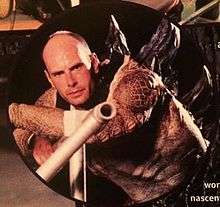Creature suit
| Part of a series on |
| Costume |
|---|
 |
|
Background
|
|
Society and culture |
|
Elements and methods |
|
Children |
|
Fictional |
|
Organizations |
|
People
|
|
Museums
|
Creature suits are partial-to-full-body costumes used to disguise an actor as an animal or monster for the purpose of performance. They are used in film, television, or as costumed characters in live events. Unlike mascots, they are often made with a high degree of realism. In contrast with prosthetic makeup, which is applied to an actor's skin, the wearer is not normally visible outside of their movements controlling the costume, although in some cases, part of the wearer's body is still visible (such as in the case of mermaids or other half-human monsters).
History
Creature suits have been used ever since before movies were invented. As part of his circus sideshow in London in 1846, P T Barnum had a man dressed up in a suit of an "ape man" who ate raw meat.[1] They were used starting from the early days of film as practical effects, to represent animals that were too prohibitive to train or use, such as gorillas.[2] Some films even tried to pass off costumes as real animals, which caused controversy.[3]
Creature suits were later adopted in the Japanese tokusatsu genre as suits of kaiju, or giant monsters, were animated using the suitmation technique, combining slow-motion filming and miniature sets to make them appear larger than they really were.
Creature suit technology advanced during the latter half of the 20th century to include modern materials and animatronics integrated into the costume itself, increasing their realism. The animatronics were usually puppeteered by an operator with a remote control. However, their use dropped due to the advent of CGI, which was often cheaper to implement. For example, the suit used in the television series Harry and the Hendersons cost USD $1 million.[4]
Nevertheless, despite the fluidity of CGI animals and monsters, purely visual effects are often panned, or, at least, not preferred by discerning film viewers. It is extremely difficult to mimic realistic lighting, leading to most CGI creatures and characters looking obviously fake when placed alongside real environments, especially if the film has a low budget and cannot afford sophisticated 3D modeling and rendering. Films such as Jurassic Park, which made heavy use of practical effects, including creature suits, remain well-regarded for their special effects, while CGI creatures quickly become dated as technology advances. This has led to the continued use of creature suits in modern-day films and commercials to provide additional realism, such as Hellboy and Star Wars: The Force Awakens.
In other instances, CGI and creature suits are combined, using green parts of the suit to chroma key them and add or remove appendages in post-production. This technique was used to hide suit actors' heads in the 2005 film Zathura, replace satyr creatures' legs in the 2005 film The Chronicles of Narnia: The Lion, the Witch and the Wardrobe, and to add facial expressions to the monsters in the 2009 film Where the Wild Things Are.
Creature suits have also been used in many live events and productions, such as the dinosaur suits used in Walking with Dinosaurs: The Arena Spectacular. They are also used in LARPs to represent monsters and other creatures that have to interact with players. In addition, they are sometimes used in hoaxes, such as Bigfoot sightings.[5][6]
Manufacture
Creature suits are usually made by special effects studios, one of the most well known of which is Jim Henson's Creature Shop, or by individual special effects artists. Different body shapes of suits are made using foam padding covered by painted liquid latex (to simulate bare skin) or fake fur. Foam latex can also be used to create suits, and masks may sometimes be made out of fiberglass. More expensive suits have hairs hand-knitted into the foam to give a more realistic, movie-quality appearance, as well as animatronic parts.
Sometimes, such suits are made by cosplayers, who make replicas of famous movie monsters. Some of the most commonly seen creature suits in cosplays are the Alien and Predator from their respective series. Other cosplayers make suits of characters from video games and anime. All realistic fursuits are technically creature suits.
Common types
Aliens
Many depictions of aliens in film have been done using creature suits of various types, including those in the science-fiction movie franchises Alien and Predator, the television series Doctor Who and The Tommyknockers, and the film The Hitchhiker's Guide to the Galaxy, among others. While shows like Star Trek prefer prosthetic makeup, it has led to the term "rubber forehead alien" due to the fact that most of the aliens look extremely similar to humans save for slight differences in their eye color, skin color or facial prosthetics, and creature suits can allow for more alien body shapes.
Gorilla suit
The gorilla suit is one of the most common types of creature suit, owing to its similarity to humans and of public interest.
Pantomime horse
Two-person horse and cow costumes have often been used in theater. Most of them are used for comedic effect, however, realistic ones do exist as well.
Other animals
Many other animals have been made into lifelike creature suits, including lions, tigers, bears, rhinos and elephants, kangaroos, penguins, ostriches and walruses, among others. The use of utahraptor suits was popularized by Walking with Dinosaurs: The Arena Spectacular and many similar puppet-suits have been created.
Kaiju
_Behind_the_scenes.gif)
Japanese Tokusatsu movies often use daikaiju, or giant monster suits. Suitmation (スーツメーション Sūtsumēshon) is a filmmaking technique initially developed by Eiji Tsuburaya for use in Godzilla films and then used for his Ultra Series productions. The suit actor, often moving through scale model scenery to give the impression of large size, is filmed at a higher framerate to make them appear slower. In addition, the suit actor performs their movements slowly and deliberately to emulate a slow moving creature.
In popular culture
- The cartoon franchise Scooby-Doo often features villains who wear realistic creature suits in order to scare people away until they are unmasked by the protagonists.
See also
References
- ↑ Weinstock, Professor Jeffrey (2014-01-08). The Ashgate Encyclopedia of Literary and Cinematic Monsters. Ashgate Publishing, Ltd. pp. 45–. ISBN 9781409425625. Retrieved 8 November 2014.
- ↑ Geiger, Jeffrey (2011). American Documentary Film: Projecting the Nation. Edinburgh University Press. pp. 61–. ISBN 9780748621484. Retrieved 9 November 2014.
- ↑ Geiger, Jeffrey (2011). American Documentary Film: Projecting the Nation. Edinburgh University Press. pp. 61–. ISBN 9780748621484. Retrieved 9 November 2014.
- ↑ Company, Johnson Publishing (1991-02-04). Jet. Johnson Publishing Company. pp. 62–. Retrieved 9 November 2014.
- ↑ Loxton, Daniel; Prothero, Donald R. (2013-08-13). Abominable Science: Origins of the Yeti, Nessie, and other Famous Cryptids. Columbia University Press. pp. 47–. ISBN 9780231526814. Retrieved 9 November 2014.
- ↑ Baker, Robert A. Missing Pieces: How to Investigate Ghosts, Ufos, Psychics, and Other Mysteries. Prometheus Books, Publishers. pp. 259–. ISBN 9781615924141. Retrieved 9 November 2014.
